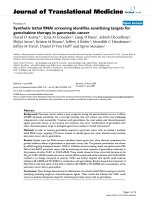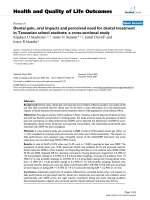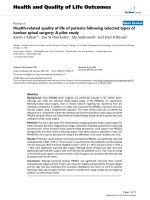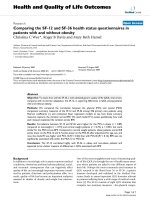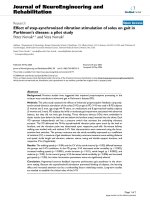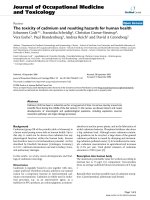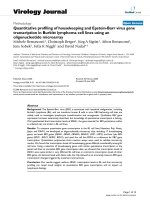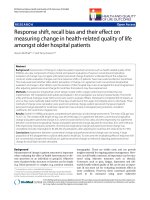báo cáo hóa học: " Dental pain, oral impacts and perceived need for dental treatment in Tanzanian school students: a cross-sectional study" docx
Bạn đang xem bản rút gọn của tài liệu. Xem và tải ngay bản đầy đủ của tài liệu tại đây (242.38 KB, 9 trang )
BioMed Central
Page 1 of 9
(page number not for citation purposes)
Health and Quality of Life Outcomes
Open Access
Research
Dental pain, oral impacts and perceived need for dental treatment
in Tanzanian school students: a cross-sectional study
Kijakazi O Mashoto
1,2,3
, Anne N Åstrøm*
1,2
, Jamil David
2
and
Joyce R Masalu
4
Address:
1
Department of Clinical Odontology, University of Bergen, Bergen, Norway,
2
Centre for International Health, University of Bergen,
Bergen, Norway,
3
National Institute for Medical Research, Dar es Salaam, Tanzania and
4
Faculty of Dentistry, Muhimbili University of Health and
Allied Sciences, Dar es Salaam, Tanzania
Email: Kijakazi O Mashoto - ; Anne N Åstrøm* - ;
Jamil David - ; Joyce R Masalu -
* Corresponding author
Abstract
Background: Dental caries, dental pain and reported oral problems influence people's oral quality of life
and thus their perceived need for dental care. So far there is scant information as to the psychosocial
impacts of dental diseases and the perceived treatment need in child populations of sub-Saharan Africa.
Objectives: Focusing on primary school students in Kilwa, Tanzania, a district deprived of dental services
and with low fluoride concentration in drinking water, this study aimed to assess the prevalence of dental
pain and oral impacts on daily performances (OIDP), and to describe the distribution of OIDP by socio-
demographics, dental caries, dental pain and reported oral problems. The relationship of perceived need
estimates with OIDP was also investigated.
Methods: A cross-sectional study was conducted in 2008. A total of 1745 students (mean age 13.8 yr, sd
= 1.67) completed an extensive personal interview and under-went clinical examination. The impacts on
daily performances were assessed using a Kiswahili version of the Child-OIDP instrument and caries
experience was recorded using WHO (1997) criteria.
Results: A total of 36.2% (41.3% urban and 31.4% rural, p < 0.001) reported at least one OIDP. The
prevalence of dental caries was 17.4%, dental pain 36.4%, oral problems 54.1% and perceived need for
dental treatment 46.8% in urban students. Corresponding estimates in rural students were 20.8%, 24.4%,
43.3% and 43.8%. Adjusted OR for reporting oral impacts if having dental pain ranged from 2.5 (95% CI
1.8–3.6) (problem smiling) to 4.7 (95% CI 3.4–6.5) (problem sleeping),- if having oral problems, from 1.9
(95% CI 1.3–2.6) (problem sleeping) to 3.8 (95% CI 2.7–5.2) (problem eating) and if having dental caries
from 1.5 (95% CI 1.1–2.0) (problem eating) to 2.2 (95% CI 1.5–2.9) (problem sleeping). Students who
perceived need for dental care were less likely to be females (OR = 0.8, 95% CI 0.6–0.9) and more likely
to have impacts on eating (OR = 1.9, 95% CI 1.4–2.7) and tooth cleaning (OR = 1.6, 95% CI 1.6–2.5).
Conclusion: Substantial proportions of students suffered from untreated dental caries, oral impacts on
daily performances and perceived need for dental care. Dental pain and reported oral problems varied
systematically with OIDP across the eight impacts considered. Eating and tooth cleaning problems
discriminated between subjects who perceived need for dental treatment and those who did not.
Published: 30 July 2009
Health and Quality of Life Outcomes 2009, 7:73 doi:10.1186/1477-7525-7-73
Received: 24 April 2009
Accepted: 30 July 2009
This article is available from: />© 2009 Mashoto et al; licensee BioMed Central Ltd.
This is an Open Access article distributed under the terms of the Creative Commons Attribution License ( />),
which permits unrestricted use, distribution, and reproduction in any medium, provided the original work is properly cited.
Health and Quality of Life Outcomes 2009, 7:73 />Page 2 of 9
(page number not for citation purposes)
Background
The usefulness of oral health related quality of life, OHR-
QoL assessments depends on their ability to predict
important outcomes and to detect intervention related
change [1]. Few attempts have been made to evaluate
OHRQoL, and to describe its relationship with perceived
dental treatment need in child-and adolescent popula-
tions of developing countries [2,3]. This is notable since
children represent a major focus of dental public health
care globally. Moreover, paediatric oral disorders are
numerous and likely to affect children's OHRQoL nega-
tively [4,5]. Instruments are now available for measuring
OHRQoL in school-aged children, such as the Child Per-
ceptions Questionnaire [4] and the Child Oral Impacts on
Daily Performance (OIDP) inventory [5]. The Child-
OIDP was developed and tested among Thai schoolchil-
dren aged 11–12 yr [5]. It has been found to be a reliable
and valid instrument when applied to children in numer-
ous countries, such as Thailand, France, UK and Tanzania
[5-8].
Untreated dental caries might lead to dental pain and
impact daily activities in terms of play, sleep, eating and
school activity [9]. In Tanzania, the exposure to dental
services is low particularly in the rural areas and although
dental caries prevalence has remained low in the child
population, dental pain and discomfort have been cited as
common reasons for seeking dental care [10]. The primary
model of treatment is tooth extraction with negligible
contribution from restorative care [10-12]. Information
on the extent, distribution and psycho-social impacts of
dental pain is important when assessing children's burden
of oral diseases and their perceived need for dental care
[3]. Reportedly, the main benefits of dental treatment
relate to improved psychological and social well-being
[13]. Thus, oral symptoms and impacts on daily activities
might constitute an adjunct assessment of perceived den-
tal treatment need [13,14]. To date, dental pain and its
psychosocial consequences pertaining to the child popu-
lations of Sub-Saharan Africa has been given little atten-
tion in the literature and the relationship of oral impacts
with perceived dental treatment need has yet to be inves-
tigated.
In a review of the literature considering dental pain
among children and adolescents, Slade [9] reported the
prevalence of toothache to range from 5% to 33% across
various countries. Shepherd et al. [15] interviewed 8-yr-
old British children and found a prevalence of dental pain
of 47.5%. In non-industrialized countries, the prevalence
and severity of children's dental pain has usually been
higher than the figures presented from UK, the USA and
Europe [16,17]. In a study of Ugandan secondary school
children, aged 13–19, toothache in the last four weeks was
estimated to 36.5% [18]. Focusing on Ugandan primary
schoolchildren, 10–14 yrs, Kiwanuka and Åstrøm [19]
reported on a prevalence of dental pain during the last 12
months amounting to 42% and 52% in boys and girls,
respectively. Recently, the reported prevalence of tooth-
ache during the previous 12 months was estimated to
41% in 11-, 13- and 15-yr- old Chinese schoolchildren
[20] and to 30% in 11–14-yr- old Pakistani schoolchil-
dren [3]. Dental pain has been reported to be prevalent
among children even in contemporary populations with
historically low levels of caries experience [9]. In the
health and lifestyle survey conducted among Finnish ado-
lescents, 1977–1997, no tendency for the prevalence of
toothache to decline across time was recorded despite a
corresponding decline in caries experience [21]. Neverthe-
less, caries – toothache associations are found to be
strongest in populations with reduced access to dental
care, in lower socio-economic status groups and in popu-
lations where dental caries is largely untreated [9].
Purpose
Focusing on primary schoolchildren resident in Kilwa,
south-eastern Tanzania, this study aimed to assess the
prevalence of dental pain and oral impacts on daily per-
formances (OIDP), and to describe the distribution of
OIDP by socio-demographics, dental caries, dental pain
and reported oral problems. The relationship of OIDP
with perceived dental treatment need was investigated in
an attempt to assess the predictive validity of the Child-
OIDP frequency questionnaire in the context of primary
schoolchildren in rural Tanzania.
Methods
Study area
The present paper is based on data generated from a cross-
sectional baseline study, which is part of a prospective
intervention that was implemented in Lindi region from
April to September 2008. Lindi, a coastal region located in
south-eastern Tanzania, is one of the most sparsely popu-
lated regions of Tanzania main land with a population
density of 66,046 per square km. The population was
791,306 as of the 2002 national census [22]. Lindi region
is divided into six districts; Lindi urban (N = 41,549),
Lindi rural (N = 215,764), Liwale (N = 75,546), Ruangwa
(N = 124,516), Nachingwea (N = 162,081) and Kilwa (N
= 171,850). Kilwa district was purposively selected for this
study, since the fluoride concentration in water (0.2 mg/
L) is low and since the district is particularly deprived with
respect to oral health care services. The district of Kilwa is
bordered in the north by the area of Coastal region, in the
east by the Indian Ocean, in the south by the rural district
of Lindi and in the west by the district of Liwale.
Study population
Kilwa district is divided into 20 wards, of which 18 are
rural (N = 7444) and 2 are urban (N = 1165). The study
Health and Quality of Life Outcomes 2009, 7:73 />Page 3 of 9
(page number not for citation purposes)
population comprised of 10–19 yr-olds attending stand-
ard 6 in public primary schools in Kilwa district. As this
study included several outcomes, the size of the sample
was calculated separately for each of them and the largest
sample size required was adopted. A sample size of 2000
primary school children was calculated to be satisfactory;
assuming that the percentage of children expected to have
dental caries was 30%, using an absolute precision (d) of
0.03, 95% CI and a design factor of 2 [23]. Some of the
schools in the selected wards were not accessible due to
natural calamities in the area at the time of data collec-
tion. Moreover, the number of enrolled subjects and
attendance rates in rural schools were particularly low. To
reach the estimated sample size, 8 rural wards (8/18 = 0.4)
were selected at the first stage by systematic random sam-
pling. In addition both urban wards were included in the
sample. At the second stage, standard 6 pupils in all pri-
mary public schools that were accessible in the urban and
in the 8 selected rural wards were included in the sample.
A total of 27 schools (N = 2465, 17 rural n = 1408 and 10
urban n = 1059) out of a total of 101 schools (N = 8609,
urban = 1165 and rural = 7444) present in Kilwa district
were invited to participate in the study (n = 2467). The
official age for entry into the primary level is 7 yrs and the
official primary level of schooling is seven standards
(grade 7). Thus, grade 6 pupils were expected to be 12 –
15-yrs- old. Permission for participation was sought from
school authorities and from parents when pupils were
below 18 yrs. Ministry of Education and Vocational Train-
ing through the District Council approved the conduct of
the study. Ethical clearance was granted by the National
Institute for Medical Research in Tanzania and the
Regional Committee for Medical Research Ethics and the
Norwegian Data Inspectorate. Written and verbal
informed consent to participate in the study was obtained
from schoolchildren and their parents.
Interview
A structured interview schedule, covering socio-demo-
graphics and various aspects of oral health was adminis-
tered by trained and calibrated research assistants and
completed by the pupils in face to face interviews. The
questionnaire was originally constructed in English, trans-
lated to Kiswahili, the national language of Tanzania, and
then back translated into English. The questionnaire was
pilot tested prior to its use in the field. Each interview was
conducted in a private and quiet place outside the class-
room. Oral health related quality of life was measured using
a Kiswahili version [8] of the eight item Child OIDP
inventory (e.g. During the previous 3 months – how often
have problems with your teeth and mouth caused you any
difficulty with; eating, speaking, cleaning teeth, smiling,
sleeping, emotional balance, study and social contact).
The students completed the Child-OIDP frequency ques-
tionnaire at school in face to face interviews administered
by two trained research assistants before the clinical exam-
ination. The interview started with the students reviewing
common oral problems, in terms of "toothache, sensitive
teeth, problems with position of teeth, ulcer in mouth,
bleeding in mouth, swollen gums, bad breath, problems
with color of teeth, problems with spaces of teeth, other
problems" and options given were (1) yes or (2) no
whether they had experienced them during the previous 3
months. The Child-OIDP frequency index referred to dif-
ficulty carrying out eight daily life activities, each scored
0–3 where (0) never, (1) once or twice a month, (2) once
or twice a week, (3) every day/nearly every day [8]. The
total Child-OIDP score was constructed in two ways. First,
by adding the 8 performance scores as originally scored
(0–3) into a Child-OIDP additive score (ADD) (range 0–
24). Second, the Child-OIDP simple count (SC) score
(range 0–8) was constructed by summing the dichot-
omized frequency items of (1) affected and (0) not
affected. The Kiswahili version of the OIDP frequency
questionnaire has previously been tested for validity and
reliability in population-based studies involving urban
primary school children in Dar es Salaam [8]. Dental pain
was computed by combining toothache and tooth sensi-
tivity into a sum score with the categories (0) no dental
pain and (1) dental pain reported. A sum score of reported
oral problems was computed from questions on broken
tooth, position of teeth, swollen gums, bad breaths, and
ulcers in the mouth, bleeding gums, colour of the teeth
and gum abscess. This score was dichotomised into (0) no
reported oral problems, (1) reported at least one oral
problem. Self assessed oral health was assessed asking:
"What do you think about the state of your teeth and
mouth?" The responses ranged from (1) very good to (4)
very bad. "How satisfied or dissatisfied are you with your
teeth or mouth, tooth appearance, tooth colour, position
of teeth, and chewing ability"? The responses for the five
questions ranged from (1) very satisfied to (4) very dissat-
isfied. A sum score for self-rated oral health was obtained
by adding the six items and then dichotomised into (0)
good/satisfied and (1) poor/dissatisfied. Perceived dental
treatment need was measured by the response to the ques-
tion "Do you perceive any need for dental treatment at the
moment? The response was either yes (1) or no (0). Par-
ents' level of education was originally scored from (1) no
education to (6) college or university education. For anal-
ysis the variables (mother's and father's education) were
recoded into (0) low education (including original cate-
gories 1 and 2) and (1) high education (including original
categories 3, 4, 5 and 6). Family wealth was assessed as an
indicator of socio-economic status according to a stand-
ard approach in equity analysis [24]. Durable household
assets indicative of family wealth (i.e. bicycle, motorcycle,
car, TV) were recorded as (1) "available and in working
condition" or (0) "not available and/or not in working
condition." These assets were analyzed using principal
Health and Quality of Life Outcomes 2009, 7:73 />Page 4 of 9
(page number not for citation purposes)
components analysis, PCA. The first component resulting
from this analysis was used to categorize households into
four approximate quartiles of wealth ranging from the 1
st
poorest quartile to the least poor 4
th
quartile
Clinical examination
Clinical examination was carried out by one trained and
calibrated dentist (KOM). Cotton roles were used to con-
trol saliva. Caries experience was assessed under field con-
ditions using natural light, probes and mouth mirror
according to the criteria described by the World Health
Organization, WHO [25]. DMFT was computed as the
sum of decayed, missed and filled teeth. Examined stu-
dents were categorized into those who were caries free
DMFT = 0 and those with caries experience DMFT>0.
Lesions were recorded as present when a carious cavity
was apparent on visual inspection. A tooth was consid-
ered missing if there was a history of extraction because of
pain and/or a cavity prior to extraction
Test-retest reliability
Duplicate clinical examinations were carried out on a ran-
domly selected sub-sample of 20 participants in one
school. Kappa values for both decayed permanent teeth
and DMFT intra-examiner agreement was 1. Kappa values
for missing and filled teeth could not be computed as the
sub-sample selected had no missed and filled teeth
Statistical analysis
Data were analysed using the Statistical Package for Social
Science (Version 15.0.1). Cluster effect was adjusted for
using STATA 10.0. Cross tabulations were tested by Chi-
square statistics. Internal consistency reliability was
assessed using Cronbach's alpha. Construct validity was
determined by comparing OIDP scores of groups that dif-
fer regarding self reported oral health status. Multivariate
analyses with OIDP and perceived dental treatment need
as outcome variables were conducted using multiple
logistic regression analyses and 95% Confidence intervals
(CI). A forced entry method was used during logistic
regression analyses and the level of significant was set at
0.05
Results
Sample profile
A total of 1780 (1780/2465, response rate 72.6%) with
mean age of 13.8 yrs (standard deviation (sd) 1.67) con-
sented to participate in the study. Being out of school at
the time of data collection was the main reason for non-
participation. Twelve students below the age of 10- and
above the age of 19 yr were excluded from the analysis.
Moreover, 23 subjects refused to be examined clinically
because of fear of the dental instruments. A total of 837
students from urban (52.3% girls, mean age 13.4 [sd
1.62]) and 908 from rural; 48.5% girls, mean age 14.2 [sd
1.64]) completed an extensive personal interview and
under-went a full mouth clinical examination. As shown
in Table 1, socio-demographic variables and self-reported
oral health varied systematically with urban-rural place of
residence. Urban residents reported dental pain and other
oral problems more frequently than rural residents.
Urban participants had parents with higher education and
belonged to the least poor 4
th
quartile on the family
wealth index more frequently than did rural participants.
Reliability and construct validity of the Child OIDP
questionnaire
In the present study, all participants completed the Child-
OIDP frequency inventory, providing support to its face
validity. Internal consistency reliability (standardized
item alpha) was 0.85 and 0.84 among urban and rural res-
idents, respectively. The inter item correlations ranged
from 0.29 (contact people) to 0.51 (speaking/sleep and
smile/emotion). The corrected item total correlation (i.e.
the correlation between each item and the total score
omitted for that item) ranged from 0. 54 (eating) to 0.63
(sleeping), being above the minimum level of 0.20 for
including an item into scale [26] Construct validity was
demonstrated in that Child-OIDP scores increased as the
students' self-reports of oral health changed from healthy
to unhealthy. Thus, a total of 27.9% versus 82% (p <
0.001) of the participants reporting good and bad dental
condition had experienced at least one OIDP.
Prevalence of dental caries, self reported pain and self
reported oral problems
The mean DMFT scores were 0.37 (sd 0.85) and 0.32 (sd
0.79) in urban and rural students, respectively. The crude
and age standardized (in parenthesis) estimates of
DMFT>0 were 17.4% (19.1%), dental pain 36.4%
(36.7%), other oral problems 54.1% (54.1%) and per-
ceived treatment need 46.8% (46.8%) in urban students.
Corresponding estimates in rural students were 20.8%
(20.9%), 24.4% (24.5%), 43.3% (43.3%) and 43.8%
(48.1%) (Table 1). Of students with DMFT>0, 51.3% and
54.0% confirmed dental pain and other oral problems,
respectively (not shown in the table).
Prevalence and correlates of OIDP
A total of 36.2% (crude prevalence rate; 41.3% urban,
31.4% rural, p < 0.001, age standardized prevalence rate;
41.5% urban and 31.4% rural) reported at least one
OIDP. The most and least frequently reported oral impact
in urban students were eating (22.8%) and smiling prob-
lems (12.5%). Corresponding figures in rural students
were cleaning (16.4%) and school work-, smiling-, emo-
tion- and speaking problems (10.2% to 10.5%) (not in
table). In the urban area, among subjects with impacts,
29.7%, 20.3% and 6.0% had respectively, 1, 2 and 8 oral
impacts. Corresponding figures among rural residents
Health and Quality of Life Outcomes 2009, 7:73 />Page 5 of 9
(page number not for citation purposes)
were 27.6%, 25.6% and 7.2%. Place of residence varied
systematically with OIDP across all impacts, except prob-
lems smiling and social contact with urban students
reporting each impact more frequently than their rural
counterparts (See table S1; additional file 1). Students in
the 3
rd
quartile of the family wealth index reported prob-
lems eating and problems cleaning more frequently than
those in the 1
st
quartile. Dental caries experience, reported
pain and oral problems varied systematically with OIDP
across the eight impacts investigated. Caries free students,
those reporting no pain and those who had no oral prob-
lems, experienced oral impacts less frequently than their
counterparts in the opposite groups. The least poor stu-
dents, according to the family wealth index, reported den-
tal pain and other oral problems more frequently than
their counterparts in the poorest 1
st
and 2
nd
quartiles (not
shown in table).
To adjust for potential confounding factors, the associa-
tion of each OIDP item with dental caries, dental pain and
reported oral problems were estimated in multiple logistic
regression analyses, adjusting for place of residence, gen-
der, age, family wealth index and parental education. The
adjusted ORs for experiencing oral impacts if having den-
tal caries were 1.5 (95% CI 1.1–2.0) regarding problems
eating, 2.2 (95% CI 1.5–2.9) regarding problems sleeping
and 1.5 (95% 1.0–2.0) regarding problems with school
work. Adjusted OR's for having impacts if reporting pain
and experiencing other oral problems are depicted in
table S2; additional file 2. Model fit in terms of
Nagelkerke's R
2
ranged from 0.114 (11.4%) difficulty
smiling to 0.259 (25.9%) difficulty eating.
Predictive validity of OIDP
Using multiple logistic regression with perceived need for
dental treatment as outcome variable, all OIDP items and
family wealth index were entered simultaneously whilst
controlling for age, gender, place of residence and paren-
tal education. Those perceiving need for dental treatment
were more likely to have problems eating (OR = 1.9, 95%
1.4 – 2.7) and cleaning (OR = 1.6, 95% CI 1.2 – 2.5) com-
pared to their counterparts without perceived need for
dental treatment. Girls were less likely to perceive need
than boys (OR = 0.8, 95% CI 0.6 – 0.9) (Table 2). Once
the main effects were established, all pairwise interaction
effects were examined. Two-way interactions occurred
between problems sleeping and problems eating on the
one hand side and urban/rural residence on the other.
Stratified analyses with urban and rural participants
revealed that whereas eating and tooth cleaning problems
were the most important predictors of perceived need in
urban schoolchildren, eating problems and sleeping
problems were the strongest predictors in their rural coun-
terparts (Table 2). Both problem eating and problem
Table 1: Socio-demographic characteristics of participants according to place of residence
Urban
% (n)
Rural
% (n)
All
% (n)
Age:
10 – 14 years 77.3 (647) 59.1 (537) 67.9 (1184)
15 – 19 years 22.7 (190) 40.9 (371)** 32.1 (561)
Sex:
Male 47.7 (399) 51.5 (468) 49.7 (867)
Female 52.3 (438) 48.5 (440) 50.3 (878)
Mother's education:
Low 38.3 (325) 50.1 (455) 44.7 (780)
High 61.2 (512) 49.9 (453)** 55.3 (965)
Father's education:
Low 39.2 (328) 43.8 (398) 41.6 (726)
High 60.8 (509) 56.2 (510)* 58.4 (1019)
Family wealth index:
1
st
quartile (Poorest) 22.2 (186) 30.3 (275) 26.4 (461)
2
nd
quartile 33.6 (281) 55.0 (499) 44.7 (780)
3
rd
quartile 5.7 (48) 2.5 (21) 4.0 (69)
4
th
quartile (Least poor) 38.5 (322) 12.4 (113)** 24.9 (435)
DMFT>0 17.4 (146) 20.8 (189) 19.2 (335)
Dental pain:
Yes 36.4 (305) 24.4 (222)* 30.2 (527)
Reported dental problems:
Yes 54.1 (453) 43.3 (393)* 48.5 (846)
Perceived need for dental care:
Yes 46.8 (392) 43.8 (398) 45.3 (790)
**p < 0.001; *p < 0.05
Health and Quality of Life Outcomes 2009, 7:73 />Page 6 of 9
(page number not for citation purposes)
sleeping presented a statistically significantly stronger
relationship with perceived treatment need in rural- than
in urban schoolchildren.
To explore the social dependency of perceived need fur-
ther, the two indicators of OIDP and perceived treatment
need were cross-tabulated. Among urban schoolchildren,
a total of 49.7% (59% of discordant pairs) perceived treat-
ment need in spite of having no oral impacts. Corre-
sponding figures in the rural areas was 52.3%. In urban,
33.8% (44% of discordant pairs) reported no treatment
need whilst they nonetheless reported oral impacts. Cor-
responding figure in rural area was 18.5% (31% of dis-
cordant pairs). The latter discrepancy amounted to 13%,
11.7%, 18.8% and 18.6% (p < 0.001) of children belong-
ing to the 1
st
, 2
nd
, 3
rd
and 4
th
family wealth index category,
respectively.
Discussion
This article reported upon the prevalence of dental caries
experience, dental pain, other oral problems and oral
impacts on daily performances in a deprived population
of 10–19-yr- olds attending primary school in Kilwa dis-
trict, Tanzania, detailed the association of clinical- and
self-reported oral health indicators with OIDP and exam-
ined which oral impacts on daily activities affected per-
ceived dental treatment needs. In spite of a low prevalence
of untreated dental caries (19.2%), dental pain, oral prob-
lems and oral impacts affected a significant part of the
population studied. Moreover, whereas dental caries and
reported oral problems were useful predictors of OIDP,
OIDP, in turn predicted perceived dental treatment needs
accounting for between 8% and 14% of its explainable
variance. In presenting unweighted prevalence estimates,
the present study is limited in that the sample was not self-
weighted and thus differed in some aspects from the pop-
ulation of urban/rural schoolchildren considered. This
should be taken into consideration when interpreting the
findings pertaining to the urban and rural schoolchildren
combined.
According to the present data, the 3 months period preva-
lence of dental pain (including tooth sensitivity) and
reported oral problems of Kilwa students amounted to
30% and 48.5%, respectively. The corresponding preva-
lence rates in students with caries experience were 50%
and 54%, respectively. Obviously, if toothache and tooth
sensitivity had been assessed separately, the prevalence
estimates of dental pain would have differed. Neverthe-
less, the present results are within the range of dental pain
prevalence rates reported by Slade [9] and accord with the
1-month period prevalence of dental pain observed
among similar aged children and adolescents in Uganda,
Pakistan, China, Greece, UK and Brazil [18-20,27-29].
Comparing the present prevalence rates across young pop-
ulations worldwide should be done with caution since
various time frames and age groups are focused in the dif-
ferent studies. Using a relatively long recall period of 3
months might have led to a slight underestimation of the
prevalence rates reported in this study. Evidently, how-
ever, experience from Tanzania have indicated that a recall
period for up to 12 months does not affect the prevalence
estimates when it comes to more serious experiences (e.g.
toothache) [30]. The causes of dental pain reported in this
study should be investigated further although sequelae of
caries are the most likely reason for dental pain. This is so
since 99% of the students investigated were without treat-
ment experience in terms of tooth fillings provided by
Table 2: Perceived need for dental care regressed on socio-demographics and OIDP items- adjusted for age, gender, place of residence
and parental education
Unadjusted % (n) Adjusted total OR (95% CI) Adjusted urban OR (95% CI) Adjusted rural OR (95% CI)
Male 48.0 (416) 1 1 1
Female 42.6 (374) 0.8 (0.6–0.9) 0.7 (0.5–1.0) 0.8 (0.6–1.1)
a
1
st
quartile (poorest) 42.8 (199) 1 1 1
2
nd
quartile 42.8 (1991) 1.0 (0.8–1.2) 0.8 (0.5–1.2) 1.0 (0.7–1.4)
3
rd
quartile 58.0 (40) 1.6 (0.9–2.8) 1.5 (0.7–2.9) 1.5 (0.5–4.2)
4
th
quartile (least poor) 49.5 (219)* 1.2 (0.9–1.6) 1.0 (0.7–1.5) 1.2 (0.7–4.9)
Eat problem
No 40.0 (563) 1 1 1
Yes 67.6 (227)** 1.9 (1.4–2.7) 1.4 (1.0–2.1) 2.9 (1.7–4.9)
Cleaning
No 40.3 (566) 1 1 1
Yes 65.9 (224)** 1.6 (1.2–2.5) 2.0 (1.3–3.0) 1.2 (0.7–2.0)
Sleep
No 8.9 (85) 1 1 1
Yes 21.4 (169)** 1.2 (0.8–1.8) 1.0 (0.6–1.7) 1.8 (1.0–3.1)
Nagelkerke's R
2
0.093 0.089 0.076 0.14
*p < 0.05, **p < 0.0001
a
family wealth index
Health and Quality of Life Outcomes 2009, 7:73 />Page 7 of 9
(page number not for citation purposes)
dental therapist, dentist or traditional healers. Dental pain
estimates are recognized indicators of the oral health sta-
tus as well as a measure of quality of life [31]. The present
finding indicates that dental pain in primary schoolchil-
dren could be avoided and thus their quality of life
improved by strengthening preventive and therapeutic
dental services in sparsely populated and remote areas of
Tanzania.
Compared to the prevalence rate of Child-OIDP reported
in 10–14-yr- old primary school children in Dar es Salaam
(28%) [9], a higher prevalence rate was observed in Kilwa
students, amounting to 36%. Nevertheless, the prevalence
of OIDP observed in this study was lower than those
reported among similar age groups in other cultures and
also lower than those observed in East African adults [8].
Consistent with previous findings, the Child-OIDP index
exhibited marked floor effect, amounting to 64%. Never-
theless, this inventory exhibited sufficient discriminative
properties suggesting that it is suitable for detecting group
differences in cross-sectional studies. The higher preva-
lence rate of oral impacts seen in urban students com-
pared to their rural counterparts is in line with rural
residents presenting a healthier profile in terms of self-
reported pain and oral problems, although the level of
parental education and family wealth was most favoura-
ble among urban residents (Table 1). Thus, Kilwa students
from urban areas and of higher socio-economic status pre-
sented with higher prevalence of OIDP than did their
rural- and lower socio-economic status counterparts.
Socio-economic disparities in OHRQoL of younger age
groups have been reported previously, however with low-
income children having severe oral disease being those
experiencing the poorest OHRQoL scores [32]. Eating and
cleaning were the most frequently reported impairments
in urban as well as rural areas, a finding that is consistent
with those of other populations using the adult-and child
versions of the OIDP instrument [33-36].
Consistent with pervious studies and irrespective of socio-
economic position and dental caries experience, students
reporting dental pain and oral problems during the last 3
months were more likely than their counterparts without
such problems to present with impaired OIDP across the
8 impacts investigated [34-36]. As shown in table S2;
additional file 2, dental pain was most strongly related to
problems sleeping and difficulty to perform schoolwork
and least strongly related to problems speaking-, smiling-
and emotional stability. Thus, in Kilwa students, tooth-
ache seems to have more serious consequences for social-
than for the functional and psychological performances.
Contrary, reported oral problems were most strongly
related to problem eating and cleaning and more weakly
associated with other impairments. Obviously, the char-
acteristics of symptoms (type, frequency and severity) that
an individual experience would have varying conse-
quences on different aspects of daily performances. As dis-
cussed by Locker [31], the psychosocial impacts of oral
disorders tend to vary from individual to individual even
though the severity of their clinical condition remains the
same. Accordingly, Wong et al [37] studying the associa-
tion between toothache and oral impacts in a sample of
Hong Kong adults found toothache to be a stronger pre-
dictor of sleep- than of eating disturbances.
Understanding dental need perceptions is important for
the effective planning and implementation of oral health
care services. Consistent with theory and empirical find-
ings, impaired OHRQoL was positively associated with
perceived need for dental care in Kilwa students, indicat-
ing that a full understanding of young people's need for
dental care cannot be captured by clinical indicators
alone. These findings are consistent with previous reports,
suggesting that self-evaluations of oral health status rather
than disease presence per se are the primary determinants
of perceived dental treatment needs [13,38,39]. Consist-
ent with results of previous studies in older age groups,
the present findings suggest that normatively assessed and
perceived need for dental care differs among Tanzanian
primary schoolchildren [38]. The present results provide
insight into what oral impacts guide Kilwa students' per-
ceived need for dental care. As shown in Table 2, respond-
ents who reported problem eating, problem cleaning and
problem sleeping were those most likely to perceive a
need for dental care. Jokovic and Locker [39] found prob-
lems associated with chewing and appearance to be the
impacts most strongly associated with perceived dental
treatment need in adult populations. Future studies
should compare the performance of various OHRQoL
inventories for children in relation to reported dental pain
and perceived need for dental care. Not everybody who
perceived oral impacts reported need for dental treatment
the latter being related to factors that predispose and ena-
ble individuals to express their needs. Thus, the least com-
mon discrepancy observed- in terms of reporting no
treatment need whilst having impacts were most frequent
in urban areas and among children in the less poor wealth
categories. This indicates a social gradient in impairment
coping- or impairment reducing behaviours, suggesting
that urban children possess better ability to cope with
adversity including impaired OHRQoL as compared to
their rural counterparts. Hastie et al [40] suggested that
besides seeking professional treatment, an individual can
choose other pain and impairment coping strategies such
as self-care, seeking of social support and spiritual/reli-
gious coping.
Conclusion
Substantial proportions of students suffered from
untreated dental caries, oral impacts on daily perform-
Health and Quality of Life Outcomes 2009, 7:73 />Page 8 of 9
(page number not for citation purposes)
ances and perceived need for dental care. Dental pain and
reported oral problems varied systematically with OIDP
across the eight impacts considered. Eating- and tooth
cleaning problems discriminated between subjects who
perceived need for dental treatment and those who did
not.
Competing interests
The authors declare that they have no competing interests.
Authors' contributions
KOM: Principal investigator, conceived of the study,
designed the study, collected data, statistical analysis and
manuscript writing. ANÅ: Main supervisor, designed
study, statistical analysis and manuscript writing. JRM:
Participated in design of study. DJ: Have commented on
the paper and provided valuable guidance for manuscript
write up/
Additional material
Acknowledgements
This study was financially supported by the Faculty of Dentistry and the
Centre for International Health, University of Bergen and Statens Lånekas-
sen, Norway. The authors would like to acknowledge the Kilwa district
administrative authorities, the National Institute for Medical Research and
Ministry of Health and Social Welfare in Tanzania, and REK VEST of Nor-
way for giving permission to conduct this study. Thanks to Jacqueline
Joseph and Frank Mmbaga for their tireless work in the field and thanks to
all study participants.
References
1. Frisch MB, Clark MP, Rouse SV, Rudd MD, Paweleck JK, Greenstone
A, Kopplin DA: Predictive and treatment validity of life satis-
faction and the quality of life inventory. Assessment 2005,
12:66-78.
2. Bastos JL, Peres MA, Peres KG, Arauji CLP, Menezes AMB: Tooth-
ache prevalence and associated factors: a life course study
from birth to age 12 yr. Eur J Oral Sci 2008, 116:458-66.
3. Pau A, Khan SS, Babar MG, Croucher R: Dental pain and care
seeking in 11–14 yr old adolescents in a low income country.
Eur J Oral Sci 2008, 116:451-7.
4. Jokovic A, Locker D, Stephens M, Kenny D, Tompson B, Guyatt G:
Validity and reliability of a questionnaire for measuring child
oral health related quality of life. J Dent Res 2002, 81:459-63.
5. Gherunpong S, Tsakos G, Sheiham A: Developing and evaluating
an oral health related quality of life index for children, the
Child OIDP. Community Dent Health 2004, 21:161-69.
6. Tubert-Jeanin S, Pegon-Machat E, Gremeau-Richard C, M-M L, Tsakos
G: Validation of the French version of the Child OIDP index.
Eur J Oral Sci 2005, 113:355-62.
7. Yusuf H, Gherunpong S, Sheiham A, Tsakos G: Validation of an
English version of the Child-OIDP index, an oral health
related quality of life measure for children. Health Quality of Life
Outcomes 2006, 4:38.
8. Mtaya M, Astrom AN, Tsakos G: Applicability of an abbreviated
version of the Child OIDP inventory among primary school-
children in Tanzania. Health Quality of Life Outcomes 2007, 5:40.
9. Slade GD: Epidemiology of dental pain and dental caries
among children and adolescents. Community Dent Health 2001,
18:219-27.
10. Kikwilu EN, Mandari GJ: Dental caries and periodontal condi-
tions among primary schoolchildren in Morogoro municipal-
ity, Tanzania. East Afr Med J 2001, 78:152-6.
11. Åstrøm AN, Kida IA: Perceived dental treatment need among
older Tanzanian adults- a cross-sectional study.
BMC Oral
Health 2007, 7:9.
12. van Palenstein Helderman WH, Nathoo ZA: Dental treatment
demands among patients in Tanzania. Community Dent Oral Epi-
demiol 1990, 18:85-87.
13. Heft MW, Gilbert GH, Shelton BJ, Duncan RP: Relationship of den-
tal status, socio-demographic status and oral symptoms to
perceived need for dental care. Community Dent Oral Epidemiol
2003, 31:351-60.
14. Locker D: Concepts of oral health, disease and the quality of
life In: Slade G, ed. Measuring oral health and quality of life.
In Dental Ecology Chapell Hill: University of North Carolina;
1997:11-23.
15. Shepherd MA, Nadanovsky P, Sheiham A: The prevalence and
impact of dental pain in 8-year-old school children in Har-
row, England. Br Dent J 1999, 187:38-41.
16. Ratnayake N, Ekanayake L: Prevalence and impact of oral painin
8-year-old children in Sri Lanka. Int J Paediatric Dent 2005,
15:105-112.
17. Naidoo S, Chikte UM, Sheiham A: Prevalence and impact of den-
tal pain in 8–10 year olds in the Western Cape. SADJ 2001,
56:521-23.
18. Okullo I, Åstrøm AN, Haugejorden O: Social inequalities in oral
health and in use of oral health care services among adoles-
cents in Uganda. Int J Paediatric Dent 2004, 14:326-35.
19. Kiwanuka SN, Åstrøm AN: Self reported dental pain and associ-
ated factors in Uganda schoolchildren. Norsk Epidemiologi 2005,
15:175-82.
20. Jiang H, Petersen PE, Peng B, Tai B, Bian Z: Self assessed dental
health, oral health practices, and general health behaviours
in Chinese urban adolescents. Acta Odontol Scand 2005,
63:343-52.
21. Honkala E, Honkala S, Rimpala A, Rimpala : The trend and risk fac-
tors of perceived toothache among Finnish adolescents from
1977 to 1997. J Dent Res 2001, 80:1823-7.
22. Population and Housing Census 2002 [za
nia.go.tz/census/lindi.htm].
23. Lwanga SK, Lemeshow S: Sample size determination in health
studies: A practical mannual. Geneva, World Health Organiza-
tion; 1991.
24. Schellenberg JA, Victora C, Mushi A, de Savigny D, Schellenberg D,
Mshinda H, Bryce J: Inequities among the very poor: Health
care for children in rural southern Tanzania. Lancet 2003,
361:561-66.
25. World Health Organization: Oral health surveys: Basic Methods.
Geneva 1997.
Additional file 1
Table S1 – Subjects with oral impact on daily performance (each
item) by socio-demographics, dental caries, dental pain and self
reported dental problems. Table showing subjects with oral impact on
daily performance (each item) by socio-demographics, dental caries, den-
tal pain and self reported dental problems. In this table **p < 0.001; and
* p < 0.05.
Click here for file
[ />7525-7-73-S1.doc]
Additional file 2
Table S2 – Oral impacts on daily performances by socio-demographics,
dental caries, dental pain and dental problems. Table showing the oral
impacts on daily performances by socio-demographics, dental caries, den-
tal pain and dental problems. In this table
a
Adjusted for age, gender, place
of residence, parental education
Click here for file
[ />7525-7-73-S2.doc]
Publish with BioMed Central and every
scientist can read your work free of charge
"BioMed Central will be the most significant development for
disseminating the results of biomedical research in our lifetime."
Sir Paul Nurse, Cancer Research UK
Your research papers will be:
available free of charge to the entire biomedical community
peer reviewed and published immediately upon acceptance
cited in PubMed and archived on PubMed Central
yours — you keep the copyright
Submit your manuscript here:
/>BioMedcentral
Health and Quality of Life Outcomes 2009, 7:73 />Page 9 of 9
(page number not for citation purposes)
26. Streiner DL, Norman GR: Health measurement scales. Second
edition. Oxford Medical Publication; 1998.
27. Pau A, Baxevanos KG, Croucher R: Family structure is associ-
ated with oral pain in 12 year old Greek schoolchildren. Int J
Paediatric Dent 2007, 17:345-51.
28. Nuttall NM, Steele JG, Evans D, Chadwick B, Morris AJ, Hill K: The
reported impact of oral condition on children in the United
Kingdom 2003. Br Dent J 2006, 200:551-55.
29. Goes PS, Watt R, Hardy RG, Sheiham A: The prevalence and
severity of dental pain in 14–15 year old Brazilian schoolchil-
dren. Community Dent Health 2007, 24:217-24.
30. Moshiro C, Heuch I, Åstrøm AN, Setel P, Kvåle G: Effect of recall
on estimation of non-fatal injury rates: A community based
study in Tanzania. Injury Prevention 2005, 11:48-52.
31. Locker D: Oral health and quality of life. Oral Health Prev Dent
2004, 2(Suppl 1):247-53.
32. Locker D: Disparities in oral health related quality of life in a
population of Canadian children. Community Dent Oral Epidemiol
2007, 35:348-56.
33. Gherunpong S, Tsakos G, Sheiham A: The prevalence and sever-
ity of oral impacts on daily performances in Thai primary
schoolchildren. Health Quality of Life Outcomes 2004, 2:57.
34. Kida IA, Astrøm AN, Strand GV, Masalu JR, Tsakos G: Psychomet-
ric properties and the prevalence, intensity and causes of
oral impacts on daily performances (OIDP) in a population
of older Tanzanians. Health Quality of Life Outcomes 2006, 5:56.
35. Masalu JR, Astrøm AN: Applicability of an abbreviated version
of the oral impacts on daily performances (OIDP) scale for
use among Tanzanian students. Community Dent Oral Epidemiol
2003, 31:7-14.
36. Astrøm AN, Okullo I: Validity and reliability of the Oral
Impacts on Daily Performance (OIDP) frequency scale: A
cross-sectional study of adolescents in Uganda. BMC Oral
health 2003, 3:5.
37. Wong MCM, McMillan AS, Zeng J, lam CLK: The consequences of
orofacial pain symptoms: a population based study in Hong
Kong. Community Dent Oral Epidemiol 2008, 36:417-24.
38. Åstrøm AN, Kida IA: Perceived dental treatment need among
older Tanzanian adults- A cross-sectional study. BMC Oral
Health 2007, 7:9.
39. Jokovic A, Locker D: Dissatisfaction with oral health status in
an older adult population. J Public Health Dent 1997, 57:40-7.
40. Hastie BA, Riley JL 3rd, Fillingim RB: Ethnic differences in pain
coping: Factor structure of the Coping Strategies Question-
naire and Coping Strategies Questionnaire-Revised. J Pain
2004, 5:304-16.
